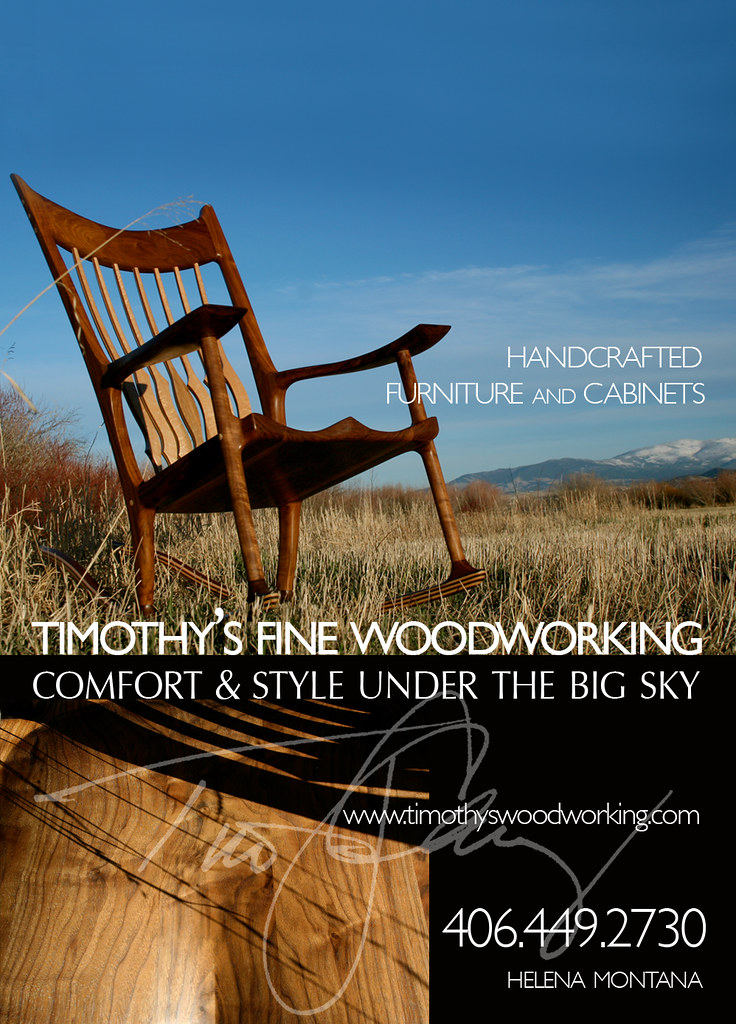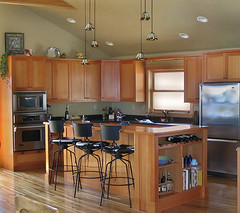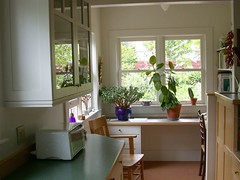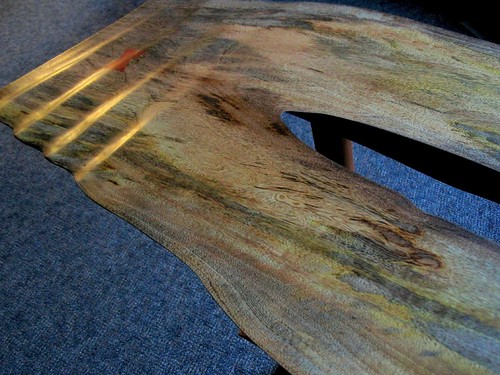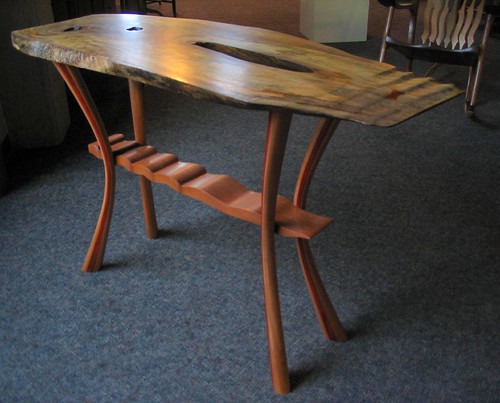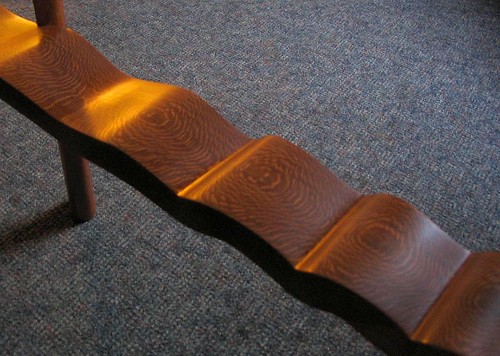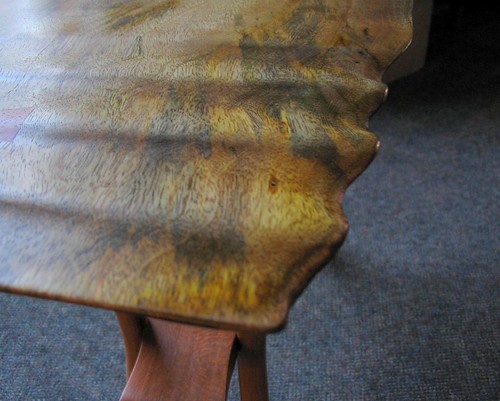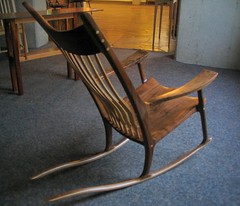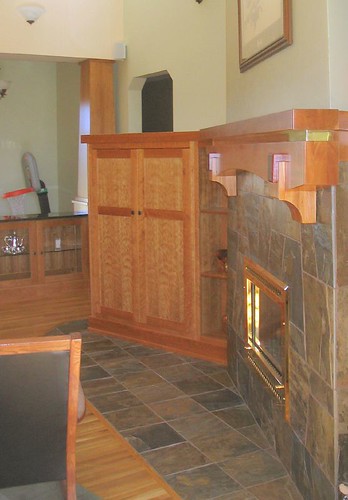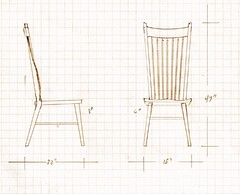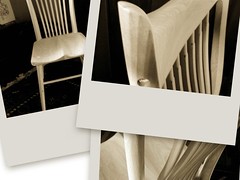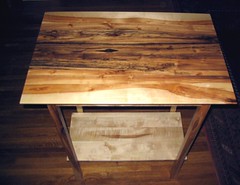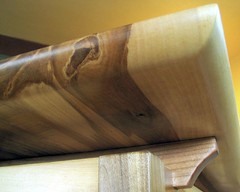Author: Timothy
Found on the Web: What does Green Really Mean?

Photo from Fine HomeBuilding pdf article. Click photo to read the article
Okay, it’s really happening — green is the latest building and design industry buzzword. Heck, even the Wall Street Journal writes that the sustainable design/green-building movement has become mainstream. You know builders have jumped on the bandwagon when the National Association of Home Builders announces that it is standardizing it’s voluntary green building guidelines.
Pick up any remodeling, home decorating, interior or architectural design magazine and you’ll find at least one feature article on going “green.” Yet how do you know, with all the green stuff coming at you from every direction, if what you are getting is really, truly green — in the sense of environmentally friendly?
Fine Home Building (Taunton Press) has long published news about the green building movement, even before it was trendy. Tim has subscribed to Fine Home Building for many years – the publication is an excellent source of inspiration, ideas and reference articles. The latest issue of FHB includs an excellent article by editor, Scott Gibson titled, What Does Green Really Mean?
Check out Scott’s article. And if you’re back this way, please leave us a comment — let us know what you think about the green building movement! Thanks for reading.
8 Ways to Make Your Home Greener
Sustainability is a word that is often misunderstood. For many people, sustainability or “green” means “environmentally friendly” But it is more than reducing waste, protecting the environment and recycling. Sustainability is a process that enables all people to realize their potential and to improve their quality of life in ways that (also) protect and enhance the Earth’s life support systemsOfrom the Forum for the Future) To understand sustainability we must become aware of how everything we do, everything we take, everything we make and everything we waste affects nature’s balance and how our actions will ultimately affect our children and all of Earth’s children.
Each choice we make has a cost that is a combination of the economic, social and environmental costs set against each choice’s benefits.
In a recent study six out of ten homeowners said they would like to use sustainable, environmentally responsible design and materials in their home projects whether that means for new home construction or home remodeling. Whether they would actually use green materials depends largely on cost and looks. Here we will take a look at both of these issues and give you some ways you can — gradually — add the color green to your new or remodeled home.
Cost has been a deterrent to many people when they are deciding whether to spring for green building materials or stick with the old tried-and-true. Because energy costs are rising sharply with no relief in sight, at least some green building materials’ costs are now closer to the non-green materials. Plus, homeowner interest in sustainable design and materials is growing rapidly — and as interest rises, so does the demand for these products, which eventually will bring costs down further. It would take a whole other article to discuss the ROI (return on investment) concept, something we’ll take up another time.
In Montana, our challenge is finding green building materials at a reasonable cost. There are added transportation costs and fewer distributors of these products in Montana. As more people ask for and demand environmentally responsible products, I hope their availability and affordability improves.
There are other ways to address the higher cost of earth-friendly materials. If you are building a new home and want to use “green” flooring such as cork, carpet made with no formaldehydes and with 100% recycled fibers, for example, it will cost lots more if you are covering 3000 square feet of floor versus if you build a smaller home in the first place and only have to install floor covering on 2000 square feet. Smaller homes are more efficient to heat as well, and the total cost of all building materials for a smaller home saves you enough that you may be able to afford to make greener choices.
 The look of green building materials is another issue. Many people are under the impression that green — environmentally responsible — design and materials, are either ugly, clunky or inelegant in appearance. This perception may be leftover from the early days of earth sheltered homes made with black painted oil drums, salvaged lumber, wine bottle walls and cedar hot tubs. On the contrary, most environmentally responsible materials and design methods today are not only beautiful, but they have a simple elegance unmatched in traditional materials. Interior designers and architects are specifying earth-friendly materials that are downright elegant and truly gorgeous. Besides, I personaloly believe salvaged lumber has a warmth and history that fits nicely with traditional or contemporary home styles.
The look of green building materials is another issue. Many people are under the impression that green — environmentally responsible — design and materials, are either ugly, clunky or inelegant in appearance. This perception may be leftover from the early days of earth sheltered homes made with black painted oil drums, salvaged lumber, wine bottle walls and cedar hot tubs. On the contrary, most environmentally responsible materials and design methods today are not only beautiful, but they have a simple elegance unmatched in traditional materials. Interior designers and architects are specifying earth-friendly materials that are downright elegant and truly gorgeous. Besides, I personaloly believe salvaged lumber has a warmth and history that fits nicely with traditional or contemporary home styles.
Okay, so how can you green your home incrementally if you don’t want to or can’t afford to do it all at once? here are 8 suggestions:
1) If you are looking for a new home, find one within walking distance of schools, workplaces, parks and grocery stores. If you can walk to most destinations, you will use less gas. To me, that means your home is greener!
2) Build on an infill lot. Most new housing has greater environmental consequences, with development replacing open space and agricultural land. New housing also requires new infrastructure such as roads and utilities. A new home built on a vacant lot (infill) uses existing roads and utilities.
3) For any new building, choose technologies such as solar panels, high R-value insulation and low-impact building methods and materials.
4) Design your new home to be more energy efficient and use less resources. You can do this by simply building a smaller, better-designed house. Large homes use more resources and may require more energy to heat and maintain than small to mid-sized homes. A smaller home on a smaller lot can be equally if not more satisfying to the soul, as author and architect, Sarah Susanka writes in her book, The Not So Big House.
4) Even better than building new, remodel an existing home to improve its’ energy efficiency. Install double-paned windows, Energy-Star appliances, an efficient furnace and hot water heater and energy efficient lighting can reduce home energy bills by over 30 percent.
 5) Remodel to make your home greener — just a little at a time. Whenever possible, choose environmentally preferable products such as low-gas paints, formaldehyde-free plywood, carpets made of recycled plastics, cork and linoleum flooring (both made of low-impact renewable resources,) countertops and kitchen cabinets made of recycled or earth-friendly materials and sustainably harvested wood.
5) Remodel to make your home greener — just a little at a time. Whenever possible, choose environmentally preferable products such as low-gas paints, formaldehyde-free plywood, carpets made of recycled plastics, cork and linoleum flooring (both made of low-impact renewable resources,) countertops and kitchen cabinets made of recycled or earth-friendly materials and sustainably harvested wood.
6) When purchasing cabinets and furnishings for your home, consider spending a little more for the best quality you can afford. Well made, classically designed cabinetry and furniture will remain stylish and last longer than cheap, lower quality home furnishings. In the end, high quality products cost you less and protect the environment because you don’t have to replace them.
7) Landscape your home — either new, or remodeled — to conserve heating and cooling energy. Plant shade trees to shield your home from hot summer sun. If you plant deciduous trees on the sunny side of your house, you will have shade in summer and sunlight in winter. Evergreen trees and shrubs can also conserve energy by lifting cold winter winds up and over the house.
8) Design your home’s landscape to conserve water and fossil fuels: read up on Xeriscaping methods, choose drought-tolerant plants, and substitute plant beds or hardscaping (deck, patio, pathways) for thirsty, energy-intensive lawns. Remember to use as many locally available materials as possible.
Certified high quality wood products
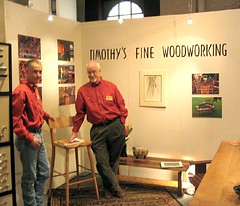
As much as possible, we build our furniture, cabinets and other home furnishings using FSC-certified wood products. That’s how we and our customers can support environmental practices without sacrificing high quality and elegant design.
Until recently it was almost impossible to find FSC-certified hardwood products and no-added-formaldehyde veneers and plywoods for our woodworking shop. Gradually, as the interest and demand for environmentally responsible materials has increased, so has the availability. The cost is also slowly coming into line with traditionally manufactured wood products. I hope that soon you will not be able to find wood products manufactured with formaldehyde glues and other environmentally degrading byproducts.
Columbia Forest Products now offers a line of 100% certified decorative wood panels and veneered particleboard that carries the Forest Stewardshop Council (FSC) ecolabel and qualifies toward the US Green Building System requirements. Visit their website for more information on this line of products.
If you are concerned about the health and environmental affects of formaldehyde-containing wood products used in your home, ask your builder, carpenter, architect or contractors to specify veneers and plywoods with no-added-formaldehydes. If enough people request these more environmentally friendly materials, the availability will increase and the cost will go down.
Inspiration: The Yellowstone
The Helena Woodworker’s Guild recently held their annual exhibit at the Myrna Loy Center for the Arts in Helena, Montana. We put the show up on December 3 and held our opening reception on December 10th, the night of the Helena Winter Art Walk. We had pieces by John Hinshaw, Priscilla Bode, Tim Carney, Travis Smith, Chris Yavah. We had great attendance at the opening, a good time and hopefully generated lots of interest in the abilities of Helena’s many talented woodworkers. We’ll be posting some photos of the exhibit and opening soon.
In the meantime, I would like to introduce Tim’s most recent one of a kind piece, The Yellowstone, inspired by one of North America’s most awesome rivers and national parks. This hall table’s live-edge slab top is made of curly mango accented with carved ripples in one end. The trestle is a sinuous fluid shape carved of lacewood and the legs’ tapered laminations are of padauk and mahogany.

Lewis River Canyon, Yellowstone Park Photo by Hayden61
Yellowstone Park is filled with natural wonders that have fascinated people for hundreds – or thousands – of years. Yet there are beautiful forces equally as passionate, hidden under the surface of the land. Firey reds, sulphuric yellows and vibrant turquoises are created by minerals pushed from deep under the earth’s crust. In Yellowstone Gorge, you can see colors in the geological layers like paint dripping on a gigantic canvas.
 And though we can see evidence of earth’s geothermal activity in the paint pots, geysers and bubbling hotsprings of the park, imagine what we can’t see … the power and lifeforce under the surface.
And though we can see evidence of earth’s geothermal activity in the paint pots, geysers and bubbling hotsprings of the park, imagine what we can’t see … the power and lifeforce under the surface.
Although the table top itself is fine to look at, if you look beneath the live-edge slab top, even through the knot holes you can see layers of the piece. Tim carved “ripples” in the table top, where the slab’s shape seemed to naturally flow like water. He chose lacewood to make a rippling trestle, because lacewood’s grain also recalls the turbulence and dancing movement of rough river whitewater. Or when a trout rises to mouth the reflecting river’s surface.
The legs are shaped with the thought of the volcanic activity and subsurface underneath Yellowstone Park.
Exhibit
Hi Ken and Mary. I’m just gonna leave this blog post up for awhile to make it easy for you to get to Tim’s flickr albums. Just click on the photo of the rocking chair (which, by the way, is the one Tim made for me – isn’t he a sweetie?) Anyway, just click on the photo and it will take you to Tim’s flickr page. In order to comment under any of his flickr photos, you have to sign up for a free flickr account (which is a very cool online photo storage service) … but I think you can make comments on any of Tim’s blog posts here at Shop Talk, without doing anything like registering. and don’t worry – we won’t spam you. [grinning]
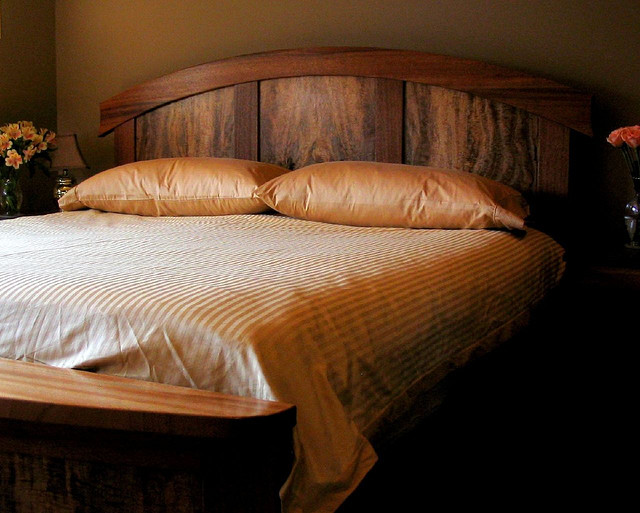
Mango & Mahogany Bedroom Set
This custom designed master bedroom set includes a mahogany and mango bed with curving headboard, a curved footboard that also functions as a seat, two bedside tables and a mahogany mirror above the owner’s black dresser.
The graceful Asian inspired lines of African Mahogany frame highly figured Curly Mango panels. The footboard curves out forming a seat that reflects the curves of the headboard and mirror. The overall feeling of the furniture contributes to a peaceful and restful bedroom atmosphere.
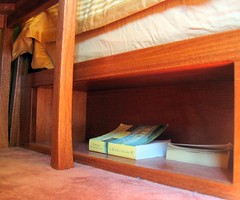
There is a bookshelf neatly tucked in the most convenient place — right up near the top of the bed. Isn’t this where books and papers tend to collect anyway? Why not make an intentional place to keep your bedtime reading?
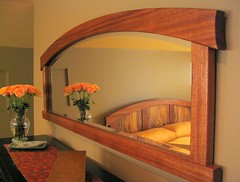 The mahogany mirror matches the bed, reflected here.
The mahogany mirror matches the bed, reflected here. 
A curved footboard also functions as a seat.
Want more storage without adding a new room to your home?
Whether you are building a new home or remodeling, you can never have too much storage. You could buy furniture specifically designed for storage (china cabinets, dressers) but then you would have that much more to dust and vacuum around … and besides, you may not have room for more furniture.
Or, you could install “built-ins” which stay with the house and increase its resale value. Design as much storage as possible into your remodeling project or new home. Custom built-ins can be economical, attractive, functional and best of all, make your life easier.
Well designed built-ins can provide convenient storage in every room and contain clutter. Built-ins make small rooms seem larger and more open because they are attached to the walls and take up less floor space.
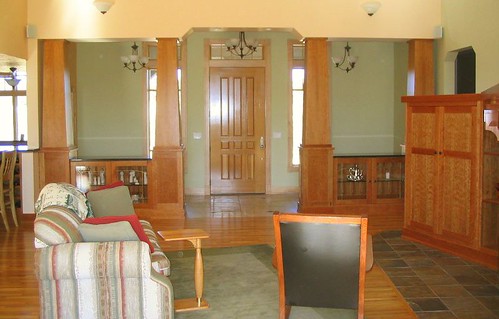
Custom built-ins can fit an oddly shaped corner or a closet you want to open up. Your furniture may be arranged around the focal point of a fireplace (above and left) yet you want to be able to watch movies without rearranging. Solve this dilemma with a built in media center flanking the fireplace. Combine the media cabinets with display shelves for a beautiful and functional living room focal point. The media center cabinets hide the television and any other clutter when not in use.
You’ll need plenty of built-in storage in a craft room, often located near the kitchen or in the laundry room or garage. No matter what your craft or hobby (sewing, woodworking, scrapbooking, etc) you can get customized drawer and cabinet inserts to fit your supplies and tools perfectly. Consider the benefits of being that organized!
 Other possible built-ins to consider for your home are a bedroom storage wall or built-in dressers, window seat benches that double as storage with recessed bookcases on the sides, a bookcase wall with media center, mud room storage benches and wall-hung cubbies, wardrobes to organize your closets, a snack bar, wet bar or coffee bar in the family room, a dining booth and a built-in desk near the kitchen (left,) a craft room storage wall with workbench, drawers and display cases, bookshelves under the stairway, dining room wall hutch or display niches for art, recessed between wall studs.
Other possible built-ins to consider for your home are a bedroom storage wall or built-in dressers, window seat benches that double as storage with recessed bookcases on the sides, a bookcase wall with media center, mud room storage benches and wall-hung cubbies, wardrobes to organize your closets, a snack bar, wet bar or coffee bar in the family room, a dining booth and a built-in desk near the kitchen (left,) a craft room storage wall with workbench, drawers and display cases, bookshelves under the stairway, dining room wall hutch or display niches for art, recessed between wall studs.
 This custom built dining room hutch (left) by Timothy’s Fine Woodworking, leaves plenty of room to expand the table for large dinner parties. The hutch has in-cabinet lights to highlight the china collection as well as lots of practical storage.
This custom built dining room hutch (left) by Timothy’s Fine Woodworking, leaves plenty of room to expand the table for large dinner parties. The hutch has in-cabinet lights to highlight the china collection as well as lots of practical storage.
There are almost endless possibilities for making more effective use of the space in your home by adding built-ins. Take advantage of the numerous cabinetmakers and woodworkers in your city or town, who can customize your home with built-in furniture, storage cabinets and display shelves. To find a woodworker who can work with you on custom built-ins, start with your local phone directory listings under “Cabinets” or “Furniture Designers & Custom Builders.”
Why build a prototype?
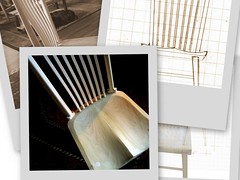
(by the way, if you want to see any of the photos on this site enlarged, just click on them)
When I design and create a custom piece of furniture such as this dining chair, I have several steps. After initial concept sketches, I draw the piece to scale. My second step is to use the scaled drawing to make a prototype — or full-scale model — of the chair. With the prototype I can test-drive the piece to make sure it is comfortable, sized correctly and most importantly, to refine the lines and forms of the design. The third step is building the actual chair. I guess there is a fourth step: making sure my customers are satisfied!
The photo above is the first version of the prototype for an armless dining chair. After contemplating the model for a day, taking it home and letting Maureen sit in it and give me her opinion, I decided to make a few changes to the chair. I change the prototype to make sure I am 100% satisfied before gluing up and cutting the walnut and curly maple I will use for the final piece.
As you can see, the prototype is very rough — for instance, the joints are not faired the way they will be in the final chair. I don’t use glue for the prototype – the joints are mechanical or fitted with screws. This makes it easy for me to take the model apart to make adjustments.
Although I was planning to fair out the chair legs anyway, I noticed from the prototype that I wanted to make the legs and seat of the chair more graceful, slightly more curved and rounded out than I had originally drawn in my sketch. I also immediately knew that I wanted the crest rail to have a more pronounced curve and that the balance between the hard lines and soft lines of the chair needed some tweaking. The joints of a prototype are extremely rough — I leave extra wood at the joints on the model. But having this new design sitting in front of me — in three dimensions made it a lot easier for me to see where I needed to make the transition points between hard and soft, and around the joints, have a more graceful flow.
All of the changes I thought of making after seeing and trying out the prototype are subtle changes, but it’s those subtle, almost invisible qualities of a piece of custom furniture that make the difference between a hohum or unattractive piece and a piece that really has soul, a beautiful well-crafted piece of furniture.
I make prototypes whenever I am working on a piece of furniture that’s totally new to me. The extra time it takes me to build a full size model is well worth it in the end results.
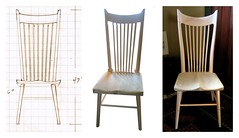 This (photo above) is the first go-round of refinements to the chair model. I’ll post more pictures of our refinements, and the finished chair as the work progresses. Thanks for stopping by my website and we’d sure appreciate it if you want to leave a comment, feedback, or ask any questions.
This (photo above) is the first go-round of refinements to the chair model. I’ll post more pictures of our refinements, and the finished chair as the work progresses. Thanks for stopping by my website and we’d sure appreciate it if you want to leave a comment, feedback, or ask any questions.
(my editor insisted on putting this pile in, just for fun.)
More views of the refined prototype:
Transforming Flaws to a Thing of Beauty
Saint Paul’s Church in Helena has recently dedicated their new church home after many years of work and fundraising for this ambitious building project. Years ago I served on the building planning committee, when we had to make the difficult decision to cut down the old birch tree near Susanna’s Place because it was in the way. We could have sited the church building a little differently, or designed it to fit around the birch, but we knew the tree was diseased and dying anyway … it’s life was close to an end and we’d be damaging the root zone so much that the weakened tree would not survive construction.
The birch was infested with birch borers — beetles and larvae. These are the same insects that are killing birch trees all over Helena and other parts of the west. When a birch or aspen is infected with borers, the tree starts dying from the top down and many people don’t notice their beautiful trees are slowly dying because they don’t look at the top branches. By the time we notice the problem, it’s often too late to save the tree. The borers are always present in our ecosystem. But when trees such as birch or aspen are stressed by many years of drought, they cannot flush out the borer larvae with a healthy flow of sap. That allows the borers to set up housekeeping and do their damage to the trees. Montana has had 8 years of severe drought. Our town’s birch trees are in grave danger unless we get more rain or water them adequately.
I write this to give you some background into why the old birch was removed when church construction began. Many church members were saddened by it’s demise. The decision to cut the birch was made easier when we thought of planking up the wood from the tree and using it in the new church building. Tim Carney has had the birch wood drying and aging in his shop for about two years. He recently finished making a beautiful table for St. Paul’s which will be used to hold the book of memorials in the new lobby.
Have you ever heard of the idea of the Wounded Healer?” Who would you turn to in a time of crisis when you need true empathy? I turn to those I know have experienced something like what I am faced with. Someone who has grappled with — and survived — the difficulties of life. Someone who is, who has been, wounded themselves. Wounded by cancer, aids, depression, alcoholism, societal prejudice, a broken heart or the loss of a loved one. A therapist who has suffered from depression knows the way depression feels — and not just from book learning. A healer who has suffered from crippling arthritis might have the greatest empathy for a patient’s struggle with pain. Recovering alcoholics are often the best folks to come to the aid of fellow alcoholics. They know the game. They know the wounds. Someone who has lost a child may be able to give the greatest comfort to parents of a stillborn baby.
So what does this have to do with a birch tree and a table?
As he worked on the table, Tim realized that he was working not only with wood planks, but also with the spirit of the diseased birch tree … and he intuitively used a poetic metaphor of how being wounded, being frail, being damaged and making mistakes can make us beautiful. And strong. It’s not the only way to transform yourself — but it is one way.
At first glance, the wood planks appeared ordinary, nothing to write home about. In fact, the wood was punky and full of rot. Tim wasn’t even sure he could salvage enough from the entire tree to make one small table. One night he came home from the shop full of excitement telling me the wood turned out to be beautiful — and it was most beautiful where the tree had been “hurt” by the insects and fungus. He chose the birch planks with care, noticing where the tree had been tunneled by borers. In those weak spots, fungus had invaded, giving the wood grain a rich, dark gleam. If not for the damage, these birch wood planks would be unremarkable.
Tim had found a way to create something of great beauty from an old tree’s wounds and “ugly” parts. If we don’t die from our illnesses … we are often made stronger … and in some ways, more beautiful. We come back to our lives and our communities filled with a renewed sense of the preciousness of life. Our spirits have more depth, more dimension. We have gone through the fire, through sickness and trouble … we have come through to the other side where our wholeness contains our wounds, our “ugly” parts, our shadow selves.
Once there was a venerable birch tree that caused much agony when a community had to choose: whether to save it or cut it. This old tree has come full circle and is back “home” with a message of hope, beauty and acceptance. It will stand in the church lobby supporting the names of those who have died, along with the names of those left behind. Like the wounded tree transformed by love and skill and vision into an object of usefulness and beauty, our own flaws can be transformed into empathy and compassion and solidarity.
written by Maureen Shaughnessy
